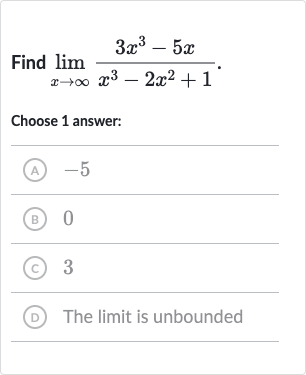Full solution
Q. Find Choose answer:(A) (B) (C) (D) The limit is unbounded
- Degree Comparison: To find the limit of the given function as approaches infinity, we can compare the degrees of the polynomials in the numerator and the denominator.
- Leading Coefficients: The degree of the polynomial in the numerator is (because of the term ), and the degree of the polynomial in the denominator is also (because of the term ).
- Limit Calculation: When the degrees of the polynomials in the numerator and denominator are the same, the limit as approaches is the ratio of the leading coefficients.
- Limit Calculation: When the degrees of the polynomials in the numerator and denominator are the same, the limit as approaches infinity is the ratio of the leading coefficients.The leading coefficient of the numerator is (from the term ), and the leading coefficient of the denominator is (from the term ).
- Limit Calculation: When the degrees of the polynomials in the numerator and denominator are the same, the limit as approaches infinity is the ratio of the leading coefficients.The leading coefficient of the numerator is (from the term ), and the leading coefficient of the denominator is (from the term ).Therefore, the limit as approaches infinity of is , which simplifies to .

